 W
WThe Blue John Cavern is one of the four show caves in Castleton, Derbyshire, England.
 W
WChislehurst Caves are a series of intersecting man-made tunnels and caverns covering some 22 miles (35.4km) in Chislehurst in southeast London, England. From the mid-13th to early 19th centuries the 'caves' were created from the mining of flint and lime-burning chalk.
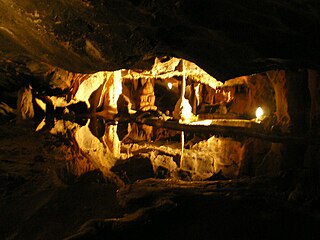 W
WCox's Cave is in Cheddar Gorge on the Mendip Hills, in Somerset, England. It is open to the public as a show cave.
 W
WDan yr Ogof, located at the National Showcaves Centre for Wales, is a 17-kilometre (11 mi) long cave system in south Wales, about 5 miles (8 km) north of Ystradgynlais and 15 miles (24 km) southwest of Brecon, in the Brecon Beacons National Park. It is the main feature of a show cave complex, which is claimed to be the largest in the UK and is a tourist attraction in Wales. The first section of the cave system is open to the public, but the extensive cave system beyond is scheduled as a national nature reserve and is open only to bona fide cavers.
 W
WGough's Cave is located in Cheddar Gorge on the Mendip Hills, in Cheddar, Somerset, England. The cave is 115 m (377 ft) deep and is 3.405 km (2.12 mi) long, and contains a variety of large chambers and rock formations. It contains the Cheddar Yeo, the largest underground river system in Britain.
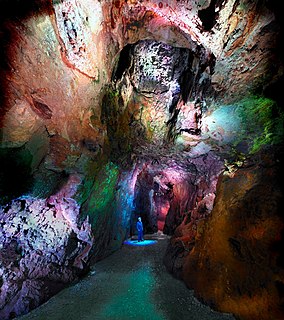 W
WGreat Masson Cavern is one of two caves at the Heights of Abraham, Matlock Bath, Derbyshire, England. The other is Great Rutland Cavern.
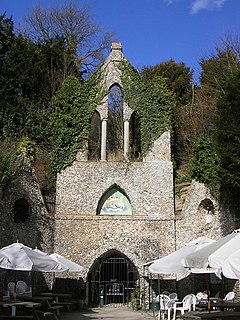 W
WThe Hellfire Caves are a network of man-made chalk and flint caverns which extend 0.25 miles (400 m) underground. They are situated above the village of West Wycombe, at the southern edge of the Chiltern Hills near High Wycombe in Buckinghamshire, Southeast England.
 W
WIngleborough Cave is a show cave close to the village of Clapham in North Yorkshire, England adjacent to where the water from Gaping Gill resurges.
 W
WKents Cavern is a cave system in Torquay, Devon, England. It is notable for its archaeological and geological features. The cave system is open to the public and has been a geological Site of Special Scientific Interest since 1952 and a Scheduled Ancient Monument since 1957.
 W
WThe Marble Arch Caves are a series of natural limestone caves located near the village of Florencecourt in County Fermanagh, Northern Ireland. The caves are named after the nearby Marble Arch, a natural limestone arch at the upstream end of Cladagh Glen under which the Cladagh River flows. The caves are formed from three rivers draining off the northern slopes of Cuilcagh mountain, which combine underground to form the Cladagh. On the surface, the river emerges from the largest karst resurgence in Ireland, and one of the largest in the United Kingdom. At 11.5 kilometres (7.1 mi) the Marble Arch Caves form the longest known cave system in Northern Ireland, and the karst is considered to be among the finest in the British Isles.
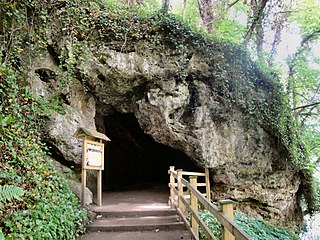 W
WMother Shipton's Cave is at Knaresborough, North Yorkshire, England, near the River Nidd. Nearby is a petrifying well, also known as a dropping well. The latter is the oldest tourist attraction to charge a fee in England, and has been operated since 1630. The water of the well is so rich in sulphate and carbonate that artefacts may be put in the well to be "petrified" (encrusted) as a tourist attraction.
 W
WThe Peak Cavern, also known as the Devil's Arse, is one of the four show caves in Castleton, Derbyshire, England. Peakshole Water flows through and out of the cave, which has the largest cave entrance in Britain.
 W
WPoole's Cavern or Poole's Hole is a two-million-year-old natural limestone cave on the edge of Buxton in the Peak District, in the county of Derbyshire, England.
 W
WClifton Observatory is a former mill, now used as an observatory, located on Clifton Down, close to the Clifton Suspension Bridge, Bristol, England.
 W
WScott's Grotto in Ware, Hertfordshire is a Grade I listed building and with six chambers the most extensive shell grotto in the United Kingdom. "It is, although on a small scale, far more complex than Alexander Pope's at Twickenham. Compared with the grotto at Stourhead, on the other hand, it is minute, but that only enhances the enchantment." The surrounding gardens and structures are Grade II* listed.
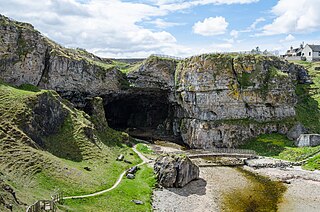 W
WSmoo Cave is a large combined sea cave and freshwater cave in Durness in Sutherland, Highland, Scotland. The cave name is thought to originate from the Norse 'smjugg' or 'smuga', meaning a hole or hiding-place.
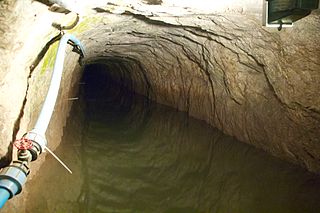 W
WSpeedwell Cavern is one of the four show caves in Castleton, Derbyshire, England.
 W
WStump Cross Caverns is a limestone cave system between Wharfedale and Nidderdale in North Yorkshire, England.
 W
WTreak Cliff Cavern is a show cave near Castleton in Derbyshire, England. It is part of the Castleton Site of Special Scientific Interest and one of only two sites where the ornamental mineral Blue John is still excavated. As part of an agreement with English Nature, the Blue John that can be seen in the show cave is not mined but it is extracted in small quantities from other areas of the cave and made into saleable items like bowls, jewellery and ornaments.
 W
WWhite Scar Caves is a show cave in the civil parish of Ingleton, North Yorkshire, England, under Ingleborough in the Chapel-le-Dale valley of the Yorkshire Dales National Park. It is a solutional resurgence cave formed in Carboniferous limestone, some 6 kilometres (3.7 mi) long.
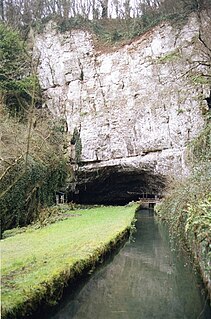 W
WWookey Hole Caves are a series of limestone caverns, a show cave and tourist attraction in the village of Wookey Hole on the southern edge of the Mendip Hills near Wells in Somerset, England. The River Axe flows through the cave. It is a Site of Special Scientific Interest (SSSI) for both biological and geological reasons. Wookey Hole cave is a "solutional cave", one that is formed by a process of weathering in which the natural acid in groundwater dissolves the rocks. Some water originates as rain that flows into streams on impervious rocks on the plateau before sinking at the limestone boundary into cave systems such as Swildon's Hole, Eastwater Cavern and St Cuthbert's Swallet; the rest is rain that percolates directly through the limestone. The temperature in the caves is a constant 11 °C (52 °F).